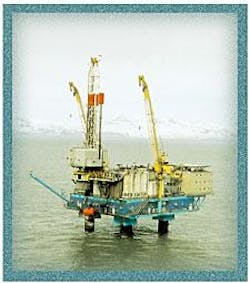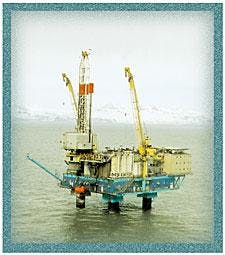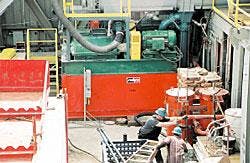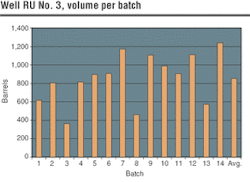Integrated fluids concept cuts costs and environmental impact in Cook Inlet
Paul White, Robert Stinson,Forest Oil Corp.
Tony Tykalsky, Dana Rhodes, Paul Hanson, M-I LLC
A system that integrates all drilling fluids and related waste management issues into a seamless approach and incor-porates a fit-for-purpose cuttings re-injection (CRI) unit has reduced disposal costs on Alaska's Osprey platform by 37% while minimizing environmental impact.
The system introduces the first zero discharge of all drilling fluids and cuttings for a development program in Alaska's Cook Inlet. To date, four exploration wells, including the longest measured depth well in the Cook Inlet, and one disposal wellbore have been completed from the platform. Installed in June 2000 to develop the prolific Redoubt Shoal structure, the platform features a specially retrofitted CRI unit, which in the four exploratory wells completed thus far, has injected nearly 57,000 bbl of drill cuttings and slurry. More importantly, all of the wells have been drilled and completed with no environmental incidents. Until completion of the dedicated disposal well, injections in the first two exploratory wells were in the annulus.
Economics
Compared to the economics associated with transporting drilling wastes to shore for treatment and disposal, the grinding of cuttings and injection operation has systematically reduced waste management costs by more than $137/bbl for an average cost of $87/bbl. On the Osprey platform, waste management and disposal represents about 8% of total project costs, while elsewhere in Alaska, collecting, treating, and disposing of drilling fluid and contaminated cuttings can run as high as 12 to 15% of the total costs of the operation.
Redoubt Shoal field
The CRI unit was specially modified for the Osprey platform, installed in 45 ft of water to exploit the Redoubt Shoal field located in the southwestern edge of the Upper Cook Inlet Basin, slightly south of the West Foreland structure. Since the completion of the first well, the productive estimate for the Redoubt Shoal structure has doubled to more than 100 MMbbl of recoverable reserves with more than 500 MMbbl estimated in place.
A total of 28 wells - seven slots per platform leg - are planned for the structure, including 18 producers, nine water-flood injectors, and one disposal well.
Operator Forest Oil, which holds a 100% interest in the field, plans to initiate first production by October. Onshore production facilities are under construction 3 mi from the platform, which will be connected via three pipelines. Solution gas produced on the platform will be sent to shore to generate the power to operate the facility. Once the Redoubt Shoal structure is on line, Alaska production will represent some 30% of Forest Oil's total worldwide output.
The production reservoir in the Redoubt Shoal field is the Oligocene Hemlock formation is comprised of interbedded sandstones and conglomerates with minor siltstone inter-beds. The thickness of the reservoir section ranges from 450 to 650 ft.
Oil-base drilling fluids
Throughout the Cook Inlet, sloughing coal raises a host of wellbore stability problems, while high torque and drag make it difficult for earlier wells to build and hold tangent to TD. Consequently, oil-base drilling fluid has proven much more effective than its water-base counterpart in providing the necessary lubricity and wellbore stability.
The Environmental Protection Agency-National Pollution Discharge Elimination System permit regulating discharges into the Cook Inlet stipulates operators are only allowed to treat and discharge cuttings generated from aqueous-based drilling fluids, providing they pass stringent sheen and toxicity tests on a daily basis. Even then, discharges are allowed for only four exploration wells and one disposal well. Consequently, as is the case with the Redoubt Shoal field, once in the development phase, all cuttings and associated wastes regardless of the base fluid must be disposed of elsewhere.
Waste management options
Given that the wells would be drilled with oil-base drilling fluids within large hole sizes in a sensitive offshore ecosystem, various scenarios for disposing of oil-base cuttings were examined early in the development planning stage. One possibility called for the construction of an onshore storage cell. It was quickly rejected, however, because of the costs and risks associated with transportation to shore and the long-term liability issues.
Another idea was to send the cuttings to the operator's West McArthur field for grinding and injection, but that proposal also was fraught with economic drawbacks, as it would require the up-front cost of building a dock facility, not to mention the daily transportation expense. The idea of shipping cuttings outside of Alaska for disposal was similarly discarded, as this option would cost $300-600/bbl.
After looking at all the options, cuttings re-injection under the auspices of the integrated fluids engineering process was selected. Once the decision was made, four critical issues were identified:
- Volume - planning and selecting the fluids systems, along with the cuttings handling, grinding, and injection hardware and contingency plans to address maximum volumes and injection rates
- Compliance - ensuring that zero discharge and annular injection permit requirements are maintained
- Space/functionality - designing fit-for-purpose cuttings handling and grind-and-inject equipment to optimize deck space utilization and processing capability, while controlling costs
- Personnel - providing a maximum number of high quality, specially trained operations and support personnel for the duration of the project.
CRI unit
The CRI unit, which was first used in Canada, was chosen for its small 30-ft by 38-ft footprint, which allowed it to be retrofitted for installation under the rig pipe deck next to the cuttings discharge auger. The unit originally was brought to the platform to handle the cuttings generated only in the 8 1/2-in. and 6 3/4-in. intervals, which were to be drilled with oil-base drilling fluid.
The original unit consisted of a multi-shear grinding mill, a 50-bbl cuttings reduction tank, a classification tanker, an 80-bbl slurry holding tank, an electrical triplex injection pump, two 100-hp vacuums, a vacuum system and an electrical panel. An additional 150-bbl slurry storage tank was constructed in Anchorage to provide additional storage of slurry between injections.
Well RU No. 1
The kick-off well, RU No. 1, was programmed to target the northern fault block. The 17 1/2-in. surface hole was drilled to 1,831 ft MD (1,815 ft TVD), where the 13 3/8-in. casing was set. The 12 1/4-in. upper intermediate hole was drilled to the 9 5/8-in. casing point at 7,000 ft MD (5,998 ft TVD). Both of these intervals were drilled at average penetration rates of 70 ft/hr using water-based drilling fluid. All fluid and cuttings were discharged overboard after clearing NPDES testing requirements.
An oil-based drilling fluid was then used before penetrating the 8 1/2-in. lower intermediate zone, which was drilled at average penetration rates of 32 ft/hr to the 7 5/8-in. casing point at 13,990 ft MD (11,616 ft TVD). The 6 3/4-in. production interval and 5 1/2-in. production liner was set at 15,282 ft MD (12,703 ft TVD). A total of 35 drilling days were required to reach TD.
In this well, all oil-base cuttings were ground up with the multi-shear grinding unit and injected into the 13 3/8-in. by 9 5/8-in. annulus. Acknowledging concerns about the mechanical integrity of the annulus, Forest Oil elected to suspend further injections. Accordingly, some 1,760 bbl of cuttings were hauled to the beach for storage until the RU No. 1D disposal well could be completed. This produced an additional cost of $2,000/d for three months for a total of $180,000, plus transportation and tank rental. The average cost of the injected slurry was $176.19/bbl.
Annular injections, which are fully permitted in Alaska, require optimum cementing of the surface casing to prevent or minimize the breaching of injected fluids to the surface. To eliminate that concern on subsequent wells, the operator on RU No. 2 and beyond drilled an 18 1/2-in. surface hole to at least 3,000 ft. The increased depth and annular volume allowed for high-quality cement isolation of the next interval.
Well RU No. 2
In the RU No. 2 well, which was programmed with four intervals to target the southern fault block, introduced the 18 1/2-in. surface hole that was drilled with water-based drilling fluid to 3,200 ft MD (2,900 ft TVD). The same fluid system was employed to drill the 12 1/4-in. upper intermediate interval drilled to the 9 5/8-in casing point at 9,001 ft MD (7,538 ft TVD). Penetration rates in these sections averaged 51 ft/hr and again, all fluids and cuttings were discharged overboard after passing the permit requirements.
The well was displaced with oil-base drilling fluid for the 8 1/2-in. lower intermediate interval, completed at 14,323 ft Md (11,747 ft TVD) and the 6 3/4-in. reservoir section, completed with a 5 1/2-in. production liner at 15,323 ft MD (12,586 ft TVD). Total drilling time was 38 days with penetration rates in the final two intervals averaging 28 ft/hr. After testing this second well, estimated recoverable reserves were revised upward from 50 MMbbl to 85 MMbbl.
In this well, 46 injections into the 13 3/8-in. by 9 5/8-in. annulus were completed successfully, at which time it was decided to suspend injections to remove concerns about annulus integrity. Accordingly, all subsequent cuttings were transported to shore awaiting completion of the RU No. 1D disposal well. On the other hand, a total of 10,090 bbl of slurry was injected, with the average cost decreasing to $59.89/bbl from the previous well.
The multi-shear unit was not capable of grinding 100% of the cuttings from the well. This resulted in 10% to 15% of the cuttings that could not be reduced sufficiently to pass through a 50-mesh shaker screen. However, the cuttings that were not reduced sufficiently comprised of coal that could easily be ground. It appeared that slivers of coal passed through the unit sideways, resulting in a considerable amount of cuttings being sent to shore until a solution was devised. The installation of the MTS 14 hammer mill processed the cuttings that could not be handled by the unit. Between the two tools, all cuttings were reduced to slurry specifications.
Disposal well
The RU No. 1D disposal well was spudded with a 12 1/4-in. surface hole to the 9 5/8-in. casing point at 2,515 ft MD and TVD. The 8 1/2-in. disposal interval was drilled to the 7 5/8-in. casing point to 8,611 ft MD and TVD. The entire disposal well, which was drilled with water-base drilling fluid, was completed in 27 days.
Because of regulatory limitations, four injections were made into the annulus of RU No. 2 while drilling the disposal well. These injections consisted of cuttings that were stored onshore from the first two wells and returned to the platform for processing. In the disposal well, the limited number of injections caused the average cost of the slurry injected to rise to $117.37/bbl.
Well RU No. 3
The third producing well, RU No. 3, targeted the southeast flank of the southern fault block. Like RU No. 2, the well was begun with an 18 1/2-in. surface hole that was drilled to the 13 3/8-in. casing point at 3,520 ft MD (7,419 ft TVD). The 12 1/4-in. upper intermediate interval, which like the previous zone was drilled with water-base mud, was completed at the 9 5/8-in. casing point at 9,335 ft MD (7,419 ft TVD). Penetration rates in the two intervals averaged 98 ft/hr and once more all fluids and cuttings were discharged after passing daily sheen and toxicity tests.
The 8 1/2-in. lower intermediate and 6 3/4-in. production zones were drilled to 15,617 ft MD (11,983 ft TVD) and 16,935 ft MD (13,014 ft TVD) respectively. Penetration rates in the two zones averaged 26 ft/hr and a total of 32 days drilling time was required to reach TD.
In this well, 14 injections totaling 11,957 bbl were made into the disposal well, with an average slurry weight of 9.5 lb/gal and an estimated drill solids disposal of 1.12 million lb. In RU No. 3, the average cost of the slurry injected dropped to $43.10/bbl.
Well RU No. 4
This well targeted the far east flank of the northern fault block and proved to be by far the most technically demanding of its predecessors. The well was completed in April as the longest measured depth well in the Cook Inlet at 20,203 ft MD.
In this final exploratory well, a total of 2,953 bbl of treated water-based drilling fluid and cuttings were discharged. In the intermediate level, 1,135 bbl of cuttings were injected into the dedicated disposal well. Another 87 bbl of cuttings were injected from the production interval.
A total of 37 injections into the disposal well were conducted on RU No. 4, totaling 30,139 bbl. In this well, the average cost dropped to $39.32/bbl.
The first zero discharge of drilling fluids and solids will begin with the drilling of the fifth well.



